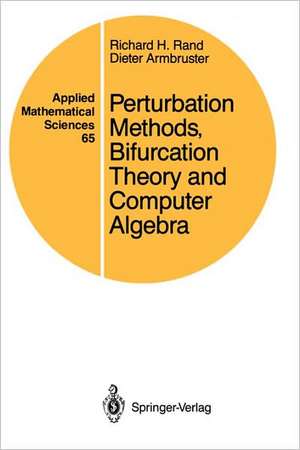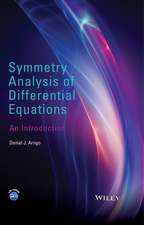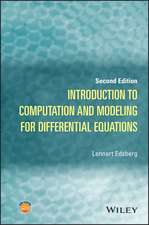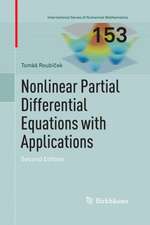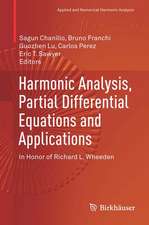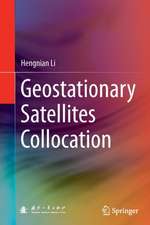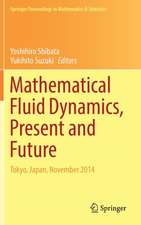Perturbation Methods, Bifurcation Theory and Computer Algebra: Applied Mathematical Sciences, cartea 65
Autor Richard H. Rand, Dieter Armbrusteren Limba Engleză Paperback – 5 oct 1987
Din seria Applied Mathematical Sciences
- 13%
 Preț: 426.94 lei
Preț: 426.94 lei - 13%
 Preț: 426.46 lei
Preț: 426.46 lei - 13%
 Preț: 427.63 lei
Preț: 427.63 lei - 24%
 Preț: 906.78 lei
Preț: 906.78 lei - 23%
 Preț: 659.05 lei
Preț: 659.05 lei -
 Preț: 375.64 lei
Preț: 375.64 lei - 18%
 Preț: 909.47 lei
Preț: 909.47 lei - 18%
 Preț: 795.02 lei
Preț: 795.02 lei - 18%
 Preț: 950.52 lei
Preț: 950.52 lei - 15%
 Preț: 645.47 lei
Preț: 645.47 lei - 20%
 Preț: 755.46 lei
Preț: 755.46 lei -
 Preț: 382.65 lei
Preț: 382.65 lei - 24%
 Preț: 808.03 lei
Preț: 808.03 lei -
 Preț: 452.62 lei
Preț: 452.62 lei -
 Preț: 190.23 lei
Preț: 190.23 lei -
 Preț: 399.12 lei
Preț: 399.12 lei - 18%
 Preț: 966.90 lei
Preț: 966.90 lei - 15%
 Preț: 643.48 lei
Preț: 643.48 lei - 15%
 Preț: 528.80 lei
Preț: 528.80 lei -
 Preț: 413.15 lei
Preț: 413.15 lei -
 Preț: 390.25 lei
Preț: 390.25 lei - 18%
 Preț: 736.01 lei
Preț: 736.01 lei - 18%
 Preț: 1411.05 lei
Preț: 1411.05 lei - 15%
 Preț: 711.21 lei
Preț: 711.21 lei -
 Preț: 395.47 lei
Preț: 395.47 lei - 18%
 Preț: 1017.26 lei
Preț: 1017.26 lei -
 Preț: 403.15 lei
Preț: 403.15 lei - 18%
 Preț: 1130.14 lei
Preț: 1130.14 lei - 18%
 Preț: 1134.87 lei
Preț: 1134.87 lei - 18%
 Preț: 1329.00 lei
Preț: 1329.00 lei - 18%
 Preț: 1129.65 lei
Preț: 1129.65 lei - 18%
 Preț: 1140.71 lei
Preț: 1140.71 lei - 15%
 Preț: 653.14 lei
Preț: 653.14 lei
Preț: 386.39 lei
Nou
Puncte Express: 580
Preț estimativ în valută:
73.94€ • 77.35$ • 61.42£
73.94€ • 77.35$ • 61.42£
Carte tipărită la comandă
Livrare economică 03-17 aprilie
Preluare comenzi: 021 569.72.76
Specificații
ISBN-13: 9780387965895
ISBN-10: 0387965890
Pagini: 251
Ilustrații: IX, 251 p. 1 illus.
Dimensiuni: 155 x 235 x 12 mm
Greutate: 0.38 kg
Ediția:Softcover reprint of the original 1st ed. 1987
Editura: Springer
Colecția Springer
Seria Applied Mathematical Sciences
Locul publicării:New York, NY, United States
ISBN-10: 0387965890
Pagini: 251
Ilustrații: IX, 251 p. 1 illus.
Dimensiuni: 155 x 235 x 12 mm
Greutate: 0.38 kg
Ediția:Softcover reprint of the original 1st ed. 1987
Editura: Springer
Colecția Springer
Seria Applied Mathematical Sciences
Locul publicării:New York, NY, United States
Public țintă
ResearchCuprins
1 Lindstedt’s Method.- 2 Center Manifolds.- 3 Normal Forms.- 4 Two Variable Expansion Method.- 5 Averaging.- 6 Lie Transforms.- 7 Liapunov-Schmidt Reduction.- Appendix Introduction to MACSYMA.- References.
